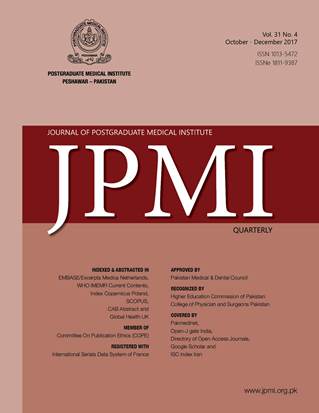TRANSLATION AND VALIDATION IN PASHTO (2): BRADFORD SOMATIC INVENTORY
Main Article Content
Abstract
Objective: To translate and validate the Bradford Somatic Inventory (BSI) in Pashto.
Methodology: This study was conducted in Peshawar from July 2015 to January 2016 on 216 participants. The participants consisted of two groups; Students (n=111), and patients (n=105). The mean age of the sample was 21.8 ± 5.6 years with majority females [n=132 (61.1%)], unmarried [n=181, (83.2%)], and were educated to a level of intermediate or higher [n= 201, (93.1%)]. Three bilingual experts, using forward-backward method, translated HADS from English to Pashto. Both, English and Pashto version of HADS were given to the participants separately. Pashto version of Bradford Somatic Inventory (BSI) was also given to find out its correlation with HADS. The data were analysed using SPSS v. 20 and AMOS.
Results: HADS Pashto version, well discriminated between both groups of participants indicating that anxiety and depression scores were significantly higher in patient group of participants as compared to students (t-value=-7.764 & p-value=0.000). Using factor analysis, it was found that the factorial validity of the Pashto version is sufficient. The Cronbachs' alpha value of the HADS Pashto version was 0.7. Regarding concurrent validity, the result showed a significant correlation between English and Pashto version of HADS (r = .716 and p value = .000) while there was a positive correlation between Pashto versions of HADS and BSI (p=.000).
Conclusion: Pashto version of the HADS is a reliable and valid measure of anxiety and depression and can be used in community as well as clinical settings.
Article Details
Work published in JPMI is licensed under a
Creative Commons Attribution-NonCommercial 2.0 Generic License.
Authors are permitted and encouraged to post their work online (e.g., in institutional repositories or on their website) prior to and during the submission process, as it can lead to productive exchanges, as well as earlier and greater citation of published work.


